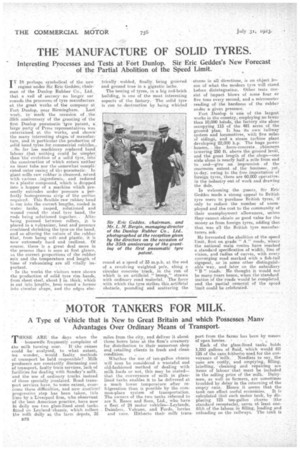MOTOR TANKERS FOR MILK.
Page 12

Page 13

If you've noticed an error in this article please click here to report it so we can fix it.
A Type of Vehicle that is New to Great Britain and which Possesses Many Advantages Over Ordinary Means of Transport.
?THESE ARE the -days when the
1 house-wife 'frequently complains of the milkturning. sour. • If -the causes could .be. analysed, to . what extent, We wonder, .would faulty methods of transport be held responsible? Milk producers .are constantly discussing cost of transport, faulty train Services, lack of facilities for dealing with Sunday's milk, and the use of ordinary truelts instead of those specially insulated. Road transport services have, to some extent, overcome these difficulties, and now anothori progressive step has been taken, this time by a Liverpool firm, who observantof the hest American practice, have now in daily use two glass-lined eteel tanks fitted on Leyland-'chassis, which 'collect the milk daily at the farm depots, 35
3328 miles Irons the city, and deliver it about three hours later at the firm's creamery for distribution to their numerous .shop and -retailing clients in fresh and clean condition.
Whether the use .of ten-gallon churns will soon be considered a wasteful and old-fashioned method of dealing with milk loads or not, this may be stated— that the conveyance of milk in glasslined tanks enables it to be delivered at a. much lower temperature after refiigeration than is possible by the common-place system of transportation. The owners of the two tanks referred to are S. Reece and Sons, Ltd., who have a fleet. of 24 motor vehicles—Leylands, Daimlers, Vulcan, and Fords, lorries
and vans. Hitherto their milk trans
port fromthe farms has been by means of open lorries.
Each of the glassflined, tanks holds 1,250 gallons of fluid, 'which would fill 125 of the eans_hitherto used for the conveyance of 'milk.: Needless to say ,y the cans are costly, and emptying, filling, labelling, cleaning and repairing are items of labour-, that must be included in the selling price of the milk. Dairymen, as well as farmers, are sometimes troubled by delay in the returning of the empty cram. Hence it seems that the tank can effect useful economies. It is calculated that each motor tank, by displacing 125 ten-gallon churns (the standard receptacle), saves at -least onefifth :of the labour in filling, loading And, unloading On the railways. The tank is
filled by means of a pipe fitted to the top (at the rear of the manhole) and frothing of the milk is prevented. The milk is drawn off at-the base. After each load of Inilk the interior of the tank is thoroughly cleaned, a man with rubber hoots entering by means of the 20-in. manhole.
The source of the milk supply is :Malpas 06 miles away). One motor tank conveys the morning milk and the other the evening supply, so that each of them does a daily mileage of 70, which permits milk to be got to the central Liverpool creamery quicker than by rail. The milk before being fed into tht tank has been pasteurized and refrigera, ted, and during the three hours' Jour ney, with an outside temperature of 80 degrees, the milk only rises in temperature 6 degrees from the moment of filling to the moment of delivery. Milk despatched in ten-gallon churns under ordinary conditions 'would pick up as much as 24 degrees of heat.
" Service to the public is our first consideration," said Mr. Harry Reece, a.'memher of S. Reece and Sons, Ltd., to a Commercial Motor roan. "In pursuit. of our ideal to supply the public with milk in the best condition possible, we considered the adoption of motor-propelled glass-lined steel tanks the best means to that end. Although the operation of these new vehicles is as yet only in an experimental stage, we believe that, from the point of view of service,
the _development will completely justify our expectations.
" Is bulk transport by means of motor tanks cheaper? If you get a full load it. is Undoubtedly so. Most of the milk coming to Liverpool by rail cads from lid. to lid. per gallon for 20 miles, hut, a.3 I have said, the major consideration is to get the liquid milk to tire depot quickly and at a low temperature. With the Motors we also have this advantage: we can arrange for the milk to he delivered at our depot just at the time we want it."
The box arrangement at the rear of the bodywork is for the storage of small solid loads,,creamery produce, cleansing powders, etc., so that each vehicle is a carrier of liquid milk and small quantities of solidi.






























